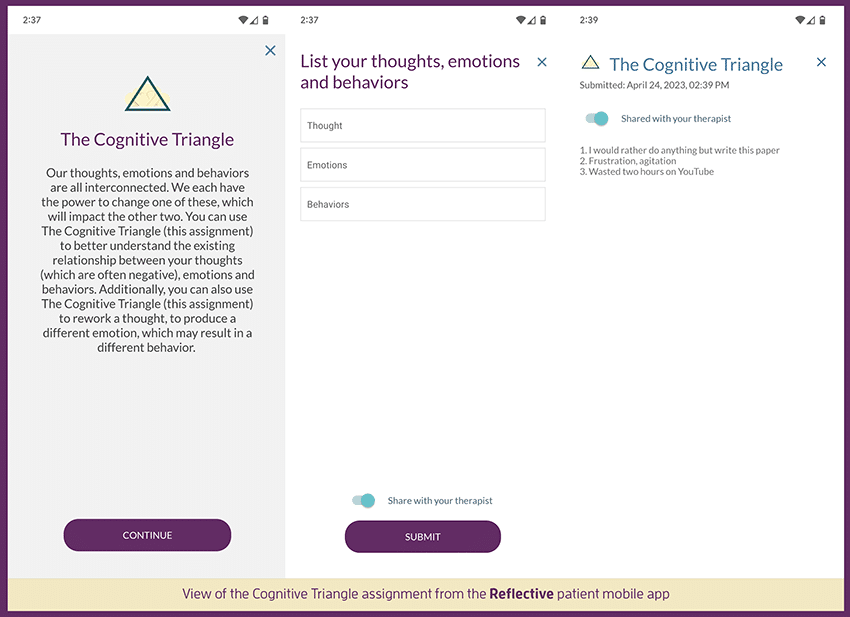What is Evidence Based Practice (EBP)?
Evidence Based Practice (EBP) revolutionized the field of mental health, providing therapists and patients with scientifically-backed methods to address various psychological challenges. By integrating clinical expertise with the best available research, EBP ensures that patients receive the most effective treatments tailored to their individual needs.
Table of Contents
- What is Evidence Based Practice in mental health?
- EBP Modalities
- Role of Homework in EBP
- Types of Assignments in EBP
- When is Therapy Homework Done?
- Benefits of Using an App in Therapy
- Learn More about Reflective
What is Evidence Based Practice in Mental Health?
Evidence Based Practice in mental health means utilizing therapeutic interventions and techniques that have been scientifically proven to be effective. It’s a commitment to ensuring that every treatment recommendation is based on empirical evidence, rather than solely on intuition or tradition.
When did Evidence Based Practice Arise?
EBP emerged in the early part of the Twentieth Century, primarily in the medical field. It was later adopted by mental health professionals who recognized the importance of grounding their practices in solid research.
In American psychology, the foundation of EBP can be compared to a three-legged stool, where each leg represents high-quality treatment outcome evidence, clinical expertise, and patient preferences and values.
History of Evidence Based Practice vs. Previous Modalities
Before the rise of EBP, many therapeutic interventions were based on theoretical foundations without substantial empirical evidence. While these methods had their merits, the shift to EBP ensured a more rigorous, research-backed approach, enhancing the credibility and effectiveness of mental health treatments.
EBP Modalities
Cognitive Behavioral Therapy (CBT)
CBT is a short-term, goal-oriented therapy that focuses on changing negative thought patterns. Founded by Dr. Aaron Beck in the 1960s, CBT has become one of the most widely practiced and researched forms of therapy. CBT worksheets help patients identify and challenge their cognitive distortions.
Dialectical Behavior Therapy (DBT)
Developed by Dr. Marsha Linehan, DBT is a form of cognitive-behavioral therapy designed primarily for individuals with borderline personality disorder. It emphasizes the balance between acceptance and change and incorporates mindfulness practices.
Acceptance and Commitment Therapy (ACT)
ACT, created by Dr. Steven Hayes, is a mindfulness-based therapy that encourages patients to embrace their thoughts and feelings rather than fighting or feeling guilty for them.
Eye Movement Desensitization and Reprocessing (EMDR)
EMDR, developed by Francine Shapiro, is a phased, focused approach to treating traumatic and other symptoms by reconnecting the client in a safe and measured way to the images, self-thoughts, emotions, and body sensations associated with the trauma.
Exposure Response Therapy
This is a form of cognitive-behavioral therapy that involves exposing individuals to the sources of their anxiety or fear, confronting the thoughts, images, objects, and situations which provoke obsessions and unhealthy compulsions, reducing those negative behaviors and feelings, creating better coping habits.
Mindfulness-Based Cognitive Therapy (MBCT)
MBCT, or mindfulness-based cognitive therapy, combines traditional cognitive behavioral approaches with mindfulness strategies. It’s particularly effective for preventing the recurrence of depression.
Somatic Experiencing Therapy (SE)
Developed by Dr. Peter Levine, SE is a body-oriented approach to healing trauma and other stress disorders.
Family Therapy
In the realm of EBP, family therapy focuses on solving systemic problems within the family unit, ensuring that solutions are backed by empirical research. An example of evidence-based practice in Family Therapy would be Functional Family Therapy (FFT), developed in the 1970s by Dr. James F. Alexander.
What is the Role of Homework in Evidence Based Practice?
Homework, exercises, and psycho-educational material play a pivotal role in EBP. They reinforce the therapeutic process, allowing patients to practice skills and integrate learning outside the therapy room. Ultimately, skills and techniques learned in session only have impact if they are practiced out in the real world, when clients are confronted by situational triggers. In evidence based practice, homework is the key to changing thoughts, feelings and behaviors.

Anxiety
Anxiety, a feeling of unease or worry, can be debilitating. Therapy homework for anxiety might include exposure exercises, where patients gradually confront their fears, or CBT worksheets that help them challenge anxiety-inducing thoughts.
Depression
Depression is characterized by persistent feelings of sadness or a lack of interest in outside stimuli. Homework for depression might involve behavioral activation tasks, encouraging patients to engage in activities they once enjoyed.
OCD
Obsessive-Compulsive Disorder (OCD) is marked by unwanted repetitive thoughts and behaviors. Homework can include exposure response therapy exercises, where patients practice skills and techniques and learn to resist the urge to perform compulsions and compulsive behaviors.
PTSD
Post-Traumatic Stress Disorder (PTSD) results from traumatic events. Homework might involve narrative exercises, where patients write about their traumas, helping them process and integrate these experiences.
Other Uses
Homework can also be beneficial for issues like phobias, sleep disorders, and relationship challenges, providing practical tools and strategies for patients to implement in their daily lives.
Types of Assignments for EBP
Basic Assignments
For therapies like CBT and DBT, assignments often include thought logs and journaling, mood trackers, and behavioral experiments. For instance, a CBT worksheet might guide a patient in challenging a negative belief, while a DBT assignment could focus on practicing distress tolerance skills.
Other Homework Types
Therapists might also assign exercises like guided meditations, breathing techniques, or journaling prompts. Practicing new habits, like setting boundaries or using positive self-talk, can also be part of the therapeutic homework.
Psycho-Educational Material
Therapists often provide links to videos, articles, or books that can enhance the patient’s understanding of their challenges and the therapeutic process. The therapist’s unique knowledge of the domain and insight into their patient helps guide their approach to assigning psycho-education content.
When is Therapy Homework Done?
In Session
Some assignments are introduced and practiced during the therapy session, providing a safe space for patients to explore new skills with their therapist’s guidance.
What are the benefits for a client to do homework assignments in-session with their therapist?
Immediate Feedback: Doing homework in-session allows the therapist to provide immediate feedback to the patient. This can help correct any misunderstandings or misinterpretations of the assignment right away.
Modeling: The therapist can model the desired behavior or thought process for the patient. This can be particularly useful for patients who learn best through observation or who are unsure about how to approach an assignment.
Motivation and Engagement: Some patients may feel overwhelmed or unsure about doing homework on their own. Completing assignments in session can boost their confidence and motivation to engage in the therapeutic process.
Clarification: It provides an opportunity for patients to ask questions and seek clarification about the assignment in real-time, ensuring they fully understand the task at hand.
Addressing Barriers: If a patient is resistant to doing homework or faces obstacles in completing it, addressing these barriers in session can be beneficial. The therapist can explore the reasons behind the resistance and work collaboratively with the patient to find solutions.
Skill Building: For certain therapeutic modalities, such as Cognitive Behavioral Therapy (CBT), in-session homework can be a way to practice and reinforce new skills. The therapist can guide the patient through the process, ensuring they are using the skills correctly.
Assessing Progress: In-session homework can serve as a tool to assess a patient’s progress. The therapist can gauge how well the patient understands and applies therapeutic concepts based on their performance on the assignment.
Building Therapeutic Alliance: Collaboratively working on assignments can strengthen the therapeutic relationship. It demonstrates the therapist’s investment in the patient’s progress and can foster a sense of teamwork.
Enhancing Generalization: Doing homework in the therapeutic setting can help patients generalize skills to other settings. They can discuss how to apply what they’ve practiced in session to real-world situations.
Overcoming Procrastination: Some patients may procrastinate or avoid homework due to anxiety, fear of failure, or other reasons. Completing assignments in session can help overcome this procrastination by providing a structured and supportive environment.
At Home at Scheduled Times
Many assignments are meant to be done at home, at specific times, allowing patients to integrate their learnings into their daily routines.
Why would a therapist want a patient to perform cognitive homework at schedule times? What are the benefits to therapeutic outcomes?
Real-world Application: Assigning homework to be done at home allows patients to apply the skills and strategies they’ve learned in therapy to real-world situations. This helps in generalizing the therapeutic interventions to their daily lives.
Consistency and Routine: Setting a scheduled time for homework can help patients develop a routine, which can be particularly beneficial for instilling new habits or behaviors. Consistency can reinforce the therapeutic interventions and make them more effective.
Autonomy and Responsibility: Completing assignments at home fosters a sense of autonomy and responsibility in patients. It encourages them to take an active role in their healing process, which can boost their self-efficacy and confidence.
Reflection and Insight: Doing homework outside of the therapy session can provide patients with the opportunity to reflect on their thoughts, feelings, and behaviors in a more naturalistic setting. This can lead to deeper insights and self-awareness.
Measurement of Progress: Homework assignments can serve as a measure of a patient’s progress. Their ability to complete assignments and the quality of their work can provide valuable information about their understanding and application of therapeutic concepts.
Enhanced Engagement: Knowing that they have assignments to complete can keep patients engaged in the therapeutic process throughout the week, not just during their sessions. This continuous engagement can accelerate the therapeutic progress.
Addressing Avoidance: For some patients, avoidance can be a significant barrier to progress. Assigning homework at specific times can challenge this avoidance by encouraging patients to confront and work through difficult emotions or situations through a repetitive habit.
Skill Mastery: Repetition and practice are key to mastering new skills. By practicing therapeutic techniques as homework, patients can become more proficient in these skills, making them more effective in managing their challenges.
Feedback Opportunity: When patients return to the next session after completing their homework, they can provide feedback on what worked, what didn’t, and any challenges they faced. This feedback is invaluable for tailoring the therapeutic approach to better suit the patient’s needs.
Build Resilience: Facing challenges while doing homework at home, and then overcoming them, can build resilience. It teaches patients that they can handle difficulties and reinforces the idea that they have the tools and skills to manage challenges.
As Situational Triggers Arise
For issues like anxiety or OCD, homework might be done when specific triggers arise, helping patients apply coping strategies in real-time.
What does it mean to perform homework exercises as situational triggers arise? What are the benefits?
Immediate Application: When patients apply therapeutic techniques during real-life triggering situations, they can immediately see the relevance and effectiveness of what they’ve learned. This real-time application can enhance their understanding and mastery of therapeutic skills.
Enhanced Relevance: Working on assignments as triggers arise ensures that the therapeutic interventions are directly relevant to the patient’s current challenges. This can increase their motivation and engagement in the therapeutic process.
Real-time Feedback: By practicing therapeutic techniques during actual triggering situations and then discussing the outcomes in therapy, patients can receive feedback on their responses. This can help refine their skills and strategies.
Increased Self-awareness: Addressing triggers as they arise can heighten patients’ self-awareness. They become more attuned to their emotional and behavioral responses, which can be crucial for therapeutic progress.
Building Resilience: Confronting and managing triggers in real-time can bolster resilience. Patients learn that they can navigate challenging situations using the tools and strategies they’ve acquired in therapy.
Reduce Avoidance: By addressing triggers head-on, patients can reduce avoidance behaviors. Avoidance can be a significant barrier in many therapeutic contexts, and this approach encourages patients to face their challenges directly.
Personalization of Therapy: Since the homework is based on real-life situations that the patient encounters, it ensures that therapy is tailored to the individual’s unique experiences and needs.
Reinforce Learning: The more frequently and consistently patients apply therapeutic techniques in real-life situations, the more ingrained these strategies become. This reinforcement can accelerate the learning process.
Empowerment: Successfully navigating real-life triggers using therapeutic techniques can empower patients. They gain confidence in their ability to manage challenges and feel more in control of their emotional responses.
Naturalistic Setting: Practicing therapeutic techniques in the context of real-life triggers provides a naturalistic setting for learning. This can enhance the generalizability of the skills learned, ensuring that patients can effectively use them outside of the therapy room.
Considerations
It’s essential for therapists to consider the patient’s readiness, ensuring that homework is neither too easy nor too challenging. The goal is to promote growth without causing undue stress.
How Using an App Facilitated by a Therapist Can Improve Treatment
Difficulties Writing
Many patients struggle with the act of writing, either due to physical challenges or mental blocks. Apps provide an accessible alternative.
Reminders
Scheduled reminders on a patient’s app can significantly boost homework compliance, ensuring consistent practice.
Convenience
With mobile apps, patients can complete assignments anytime, anywhere, making the therapeutic process more integrated into their daily lives.
Real-Time Insights
Apps allow therapists to gain real-time insights into their patients’ progress, enabling more tailored feedback and guidance.
Accountability
Knowing that a therapist can view their progress can motivate patients to stay consistent with their assignments.
Learn More about Using Reflective
Reflective offers a seamless way to assign homework exercises and psycho-educational material. With a user-friendly mobile app, patients receive reminders and can easily access only the assignments tailored to them, enhancing their therapeutic journey.



